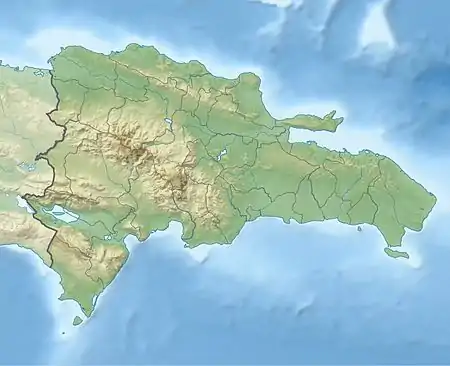Baitoa Formation
The Baitoa Formation is a geologic formation in Dominican Republic. The formation consists of siltstones and limestones deposited in a shallow marine to reef environment. The formation, unconformably overlying the Tabera Formation and unconformably overlain by the Cercado Formation, preserves bivalve, gastropod, echinoid and coral fossils dating back to the Burdigalian to Langhian period.[1]
| Baitoa Formation Stratigraphic range: Burdigalian-Langhian | |
|---|---|
| Type | Formation |
| Underlies | Cercado Formation |
| Overlies | Tabera Formation |
| Lithology | |
| Primary | Siltstone, limestone |
| Location | |
| Coordinates | 19.3°N 70.7°W |
| Approximate paleocoordinates | 19.2°N 69.5°W |
| Country | |
 Baitoa Formation (the Dominican Republic) | |
See also
References
- Baitoa Formation at Fossilworks.org
Further reading
- S. D. Cairns and J. W. Wells. 1987. Neogene paleontology in the northern Dominican Republic, 5. The suborders Caryophylliina and Dendrophylliina (Anthozoa, Scleractinia). Bulletins of American Paleontology 93(328):23-43
- L. Dolin. 1991. Cypraeoidea and Lamellarioidea (Mollusca: Gastropoda), from the Chipola Formation (late early Miocene) of northwestern Florida. Tulane Studies in Geology and Paleontology 24(1-2):1-60
- A. B. Foster. 1986. Neogene paleontology in the northern Dominican Republic, 3. The family Poritidae (Anthozoa, Scleractinia). Bulletins of American Paleontology 90:47-123
- J. B. Saunders, P. Jung, and B. Biju-Duval. 1986. Neogene Paleontology in the Northern Dominican Republic: 1. Field Surveys, Lithology, Environment, and Age. Bulletins of American Paleontology 89(323):1-79
- H. E. Vokes and E. H. Vokes. 1968. Variation in the genus Orthaulax (Mollusca: Gastropoda). Tulane Studies in Geology and Paleontology 6(2):71-84
This article is issued from Wikipedia. The text is licensed under Creative Commons - Attribution - Sharealike. Additional terms may apply for the media files.